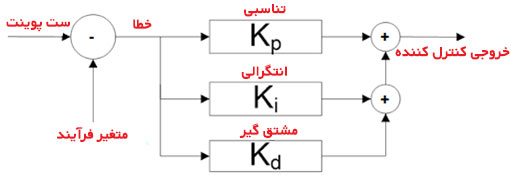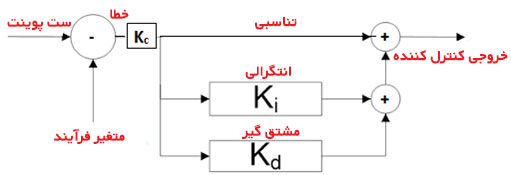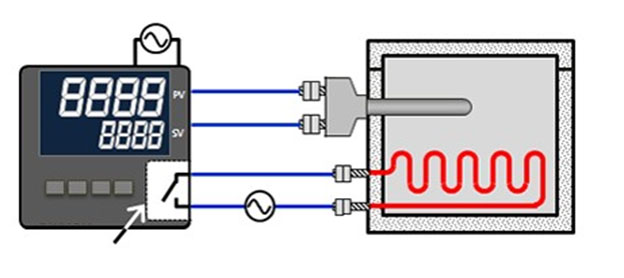Temperature controller
What is a temperature controller?
As the name implies, a temperature controller is a device used to control the temperature of an industrial process without the need for an operator. In this system, the temperature controller receives the output temperature of a temperature sensor such as a thermocouple or RTD, and compares the actual temperature sensed by the sensor with the required temperature set by the operator in the device, and the appropriate output to Sends control equipment such as a fan or an element to which it is connected.
Types of temperature controllers and how they work
Temperature controller ON / OFF
The ON / OFF controller is the simplest type of temperature controller. The output of this device is either ON or OFF and has no intermediate mode. This type of controller gives output only if the input temperature exceeds the set point number of the device. To control the heat, the output is ON when the temperature is below the set point number and OFF when the temperature is above the set point number. When the temperature passes the set point to change the output state, the process temperature continues in a cyclical manner, rising above the set point temperature, or vice versa. In cases where this cycle occurs rapidly, a differential ON / OFF or hysteresis is added to the controller functions to prevent failure of the contactors and valves. This differential is required when the temperature exceeds the set point by a certain value before the output is ON or OFF. Differential ON / OFF prevents hitting the output or fast and continuous switches. The ON / OFF controller is used when we do not need very precise control, for example in systems where the amount and volume of the system is very large and the temperature changes very slowly, or it is used for temperature alarms. A special type of ON / OFF controller used for alarms is a LIMIT CONTROLLER. This controller uses a LATCHING relay that must be reset manually and is used to SHOUT DOWN the process when we reach a certain temperature.
In general, in these controllers, things like overclocking and oscillating motion occur a lot and it is impossible to eliminate these cases. The ON / OFF controller is obsolete and can only be used in cases where accuracy is not important.
Proportional Temperature Controller
Proportional controllers are designed to eliminate ON / OFF control cycles. When the temperature reaches the set point, a proportional controller reduces the average power applied to the heater. The effect is to reduce the speed of the heater, which causes the temperature not to exceed the set point number, so the temperature reaches the set point number and remains constant at the same point. This proportional function can be performed by turning the output on and off at short intervals. In this type of operation, the ON and OFF time ratios change to control the temperature. This function occurs around the set point. Outside of this range, the controller acts like a simple ON / OFF controller. However, within the mentioned interval, the output is ON and OFF in proportion to the difference measured from the set point.
PID temperature control
PID controller to measure physical parameters such as pressure, temperature, surface, flow and. Etc. are used. PID stands for Propotional Integral Derivative and is based on three control modes: proportional, integral and derivative.
Proportional control
Based on the current state of the system under control and the measured value is compared to the set value and the control signal is sent in proportion to the instantaneous error range.
Integral control
The system is controlled based on the past state, and the control signal is generated based on the error amplitude at past times.
Derivative control
The performance of this function is based on the future state of the control system and the control signal depends on the amount of error changes. The PID controller generates a control signal based on the three states of the system, past, present and future, and is used in many industrial processes.
PID temperature controller structure
The structure of temperature controllers has a direct effect on the setting of controllers, the types of PID temperature controller structure are as follows:
PID temperature controller with parallel structure
PID temperature controller with non-interactive structure (standard, ideal, ISA)
PID temperature controller with interactive structure (real, series, classic)
PID temperature controller with parallel structure

This structure is used in distributed control systems and PLC controllers. It is difficult to adjust this structure.
PID temperature controller with non-interactive structure (standard, ideal, ISA)

Cohen-Coon and Lambda algorithms are used for this type of configuration.
PID temperature controller with interactive structure (real, series, classic)

The structure of the early pneumatic and electronic controllers was interactive. There are currently a variety of controllers with an interactive structure.
This control model is the most accurate and stable type of control and is very suitable for systems that have a small volume and react quickly to energy changes applied to the system. This type of controller is recommended for systems that change frequently and the controller is expected to automatically adjust these changes in setpoint, changes in energy or volume.
Advantages of PID temperature controller
Simple structure
Convenient adjustment
Eliminate steady state error
Convenient implementation
low price
Commercial module
Temperature controller output
Temperature controllers are responsible for establishing communication and changing the status to reach the desired temperature of the equipment and the output value is the output voltage of 0 to 5 volts DC or current 4 to 20 mA. The outputs of the temperature controller are as follows
Relay output
Solid state relay (SSR) output
Relay output

The output of the relay is of the current type and is regulated by the output current of the controller.
At the relay output, the controller has an internal contact that is connected in series to the output equipment and causes it to turn on or off.
If we need more power, we put a magnetic contact outside the controller.
Solid state relay (SSR) output
In SSR output, the output is voltage and produces 12 volts, the solid state relay receives commands by this voltage and controls the equipment according to the output value of the temperature controller.
Solid state relays do not have a moving part and are used for processes that have a short time cycle.
PID controller with fuzzy control
To control the effect of perturbations, fuzzy control is added to the PID controller. In this case, the temperature difference between the set point and the actual value of the temperature is calculated and the temperature is precisely adjusted.
How to select a controller for the process
The controller is only part of a control system and the whole system must be examined to select it. The following are items that should be considered when choosing a controller.
Input sensor type (thermocouple or RTD), and temperature range
Required output type (electromechanical relay, SSR, analog output)
Required control algorithm (ON / OFF, Proportional, PID)
Number and type of outputs (heat, cold, alarm, LIMIT)
